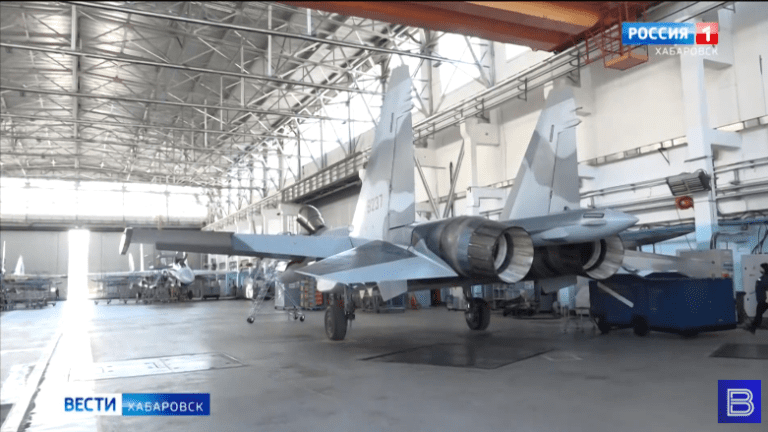Russia’s Gagarin Aircraft Plant in Komsomolsk-on-Amur (KnAAPO) is still producing Egypt’s new advanced Su-35 super flanker multirole fighter jets despite uncertainty regarding Cairo’s interests in the new jets.
Russia’s Kommersant daily announced in March 2019 that Egypt had ordered two dozen Su-35 fighter jets for about $2 billion.
“The agreement for the supply of ‘over two dozen aircraft’ and aviation aids will amount to $2 billion. The signing of the contract was carried out at the end of 2018 and the delivery of the aircraft will begin as early as 2020-21.” The report said.
Two Egyptian Su-35 fighters, #9221 and #9237, were recently seen in a video during a visit by deputies of Russia’s State Duma to the Komsomolsk-on-Amur Aircraft Plant. The two Su-35s we’re nearing completion.
Gagarin Aircraft Plant in Komsomolsk-on-Amur began serial production of Egypt’s new advanced Su-35 super flanker multirole fighter jet two years ago.
Threat of US Sanctions
The Su-35 deal has suffered setbacks since it’s signing in 2018, chief amongst them is the growing US pressure on countries worldwide not to buy Russian-produced arms.
US Defense Secretary Mark Esper and Secretary of State Mike Pompeo warned that if Egypt goes ahead with its planned purchase of the Russian built Sukhoi Su-35 superflanker fighter jet, the US could enact sanctions on Egypt through the Countering America’s Adversaries Through Sanctions Act of 2017 (CAATSA).
CAATSA requires the US to sanction anyone conducting transactions with the Russian intelligence and military services, including arms manufacturers.
News of suspected collapse of Su-35 deal was reported on account of economic sanctions imposed on Moscow, largely targeting oil companies and military technologies.
Following defence-related sanctions from the US, Russia faces the prospect of being unable to manufacture new weapons systems and uncertainty hangs over how it will deliver on its export contracts while it wages war in Ukraine and deals with a catastrophic economic crisis.
Egypt’s Su-35s are ready for ddelivery
Nevertheless, Russia proceeded with the manufacturing of the aircraft, with the first batch concluding it’s flight tests in July 2020. The first five Sukhoi Su-35 fighters for the Egyptian Air Force were photographed at Novosibirsk Tolmachevo Airport en route from the Komsomolsk-on-Amur Aircraft Plant.
The five Su-35 aircraft with production serial numbers (9210, 9211, 9212, 9213, 9214) has been completed.
By June 2021, 17 of the fighters had been completed to meet Egyptian orders.
US offers F-15s to Egypt
In response to the planned purchase of the Russian jets, Washington is tried to coax Cairo away from its Su-35 deal, by granting Egypt permission to purchase the Su-35’s closest Western competitor the F-15 Eagle.
A deal which is strongly supported by regional rival and neighbor Israel as part of Jerusalem’s efforts to improve relations between Cairo and Washington. Although Egypt’s interest in the American fighter has not been confirmed.
“In the case of Egypt, I think we have good news in that we’re going to provide them with F-15s,” Gen. Frank McKenzie, head of US Central Command, told the Senate Armed Services Committee. It “was a long, hard slog” to get such a deal set up, he added.
Egypt’s worried about US sanctions
For a long time, Egypt has been cautious regarding heavily relying on the United States for its of military hardware, and particularly sensitive systems such as fighter aircraft. , with the U.S. notably having embargoed the country in 2013 which seriously undermined its ability to launch key counterinsurgency operations against Islamist militants.
When the US warned about possible CAATSA sanctions on Egypt, several high-ranking government officials and ex-military commanders, warned that these sanctions would be considered unacceptable interference in Egypt’s sovereign decision to procure arms.
Acquiring the Su-35 was seen as an attempt to diversify Cairo’s weapons suppliers, and also negate the effects of repeated U.S. rejections of its attempts to purchase U.S. military hardware.
Furthermore, the United States has followed a policy of limiting Egyptian Air Force range and capability by preventing Cairo from procuring advanced heavy air superiority fighters.
Similarly, the U.S. has for decades only supplied heavily downgraded hardware to Egypt, as well as strictly controlling how aircraft can be used including which airbases they can be deployed to and when they are permitted to fight. Russian aircraft such as the Su-35 have no such restrictions imposed.
Thus, Egypt sees the Su-35 deal as a bitter pill that it has opted to swallow to remedy its aerial inferiority.
Su-35 offers opportunity to improve aerial capability
Egypt hopes to quickly boost it’s aerial capabilities and is focusing on two strategic threats that has cropped up recently; the discovery of a large gas field in its exclusive economic zone (EEZ) in the eastern Mediterranean.
Egypt would need an effective aerial fleet with a fuel capacity larger than its short-ranged F-16 fighters to effectively secure its EEZ.
The second strategic threat is to Egypt’s south posed by the Great Ethiopian Renaissance Dam. If negotiations should fail, Egypt may resort to a military option, therefore it will need to operate an aerial fleet with a BVR capability to counter the Ethiopian Su-27 Flanker air superiority fleet, which is armed with R-27 air-to-air missiles whose range exceeds that of the Egyptian AIM-7 Sparrow, Aim-9 Sidewinder and the French MICA.
Egypt also ordered 50 MiG-29M/M2 aircraft in 2015, with deliveries between 2017 and 2020.
The MiG-29M/M2 fighters sold by Russia to Egypt were delivered together with aerial refueling equipment, allowing the use of MiG-29M/M2 fighter jets as air tankers.
On 15 January last year, the EAF released a footage of more than a dozen Egyptian MiG-29 Fulcrums taking off at the same time, as part of a readiness exercise.
